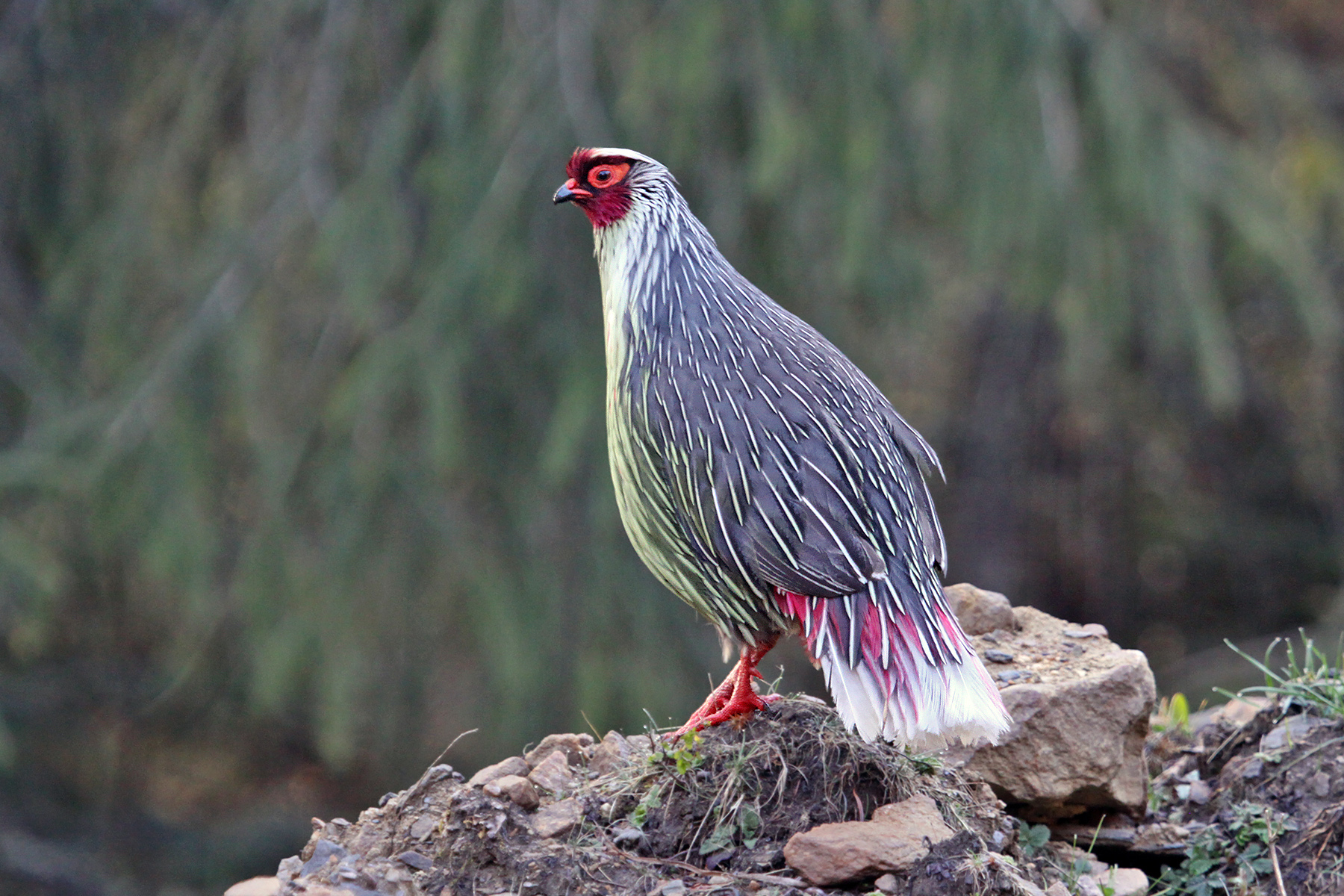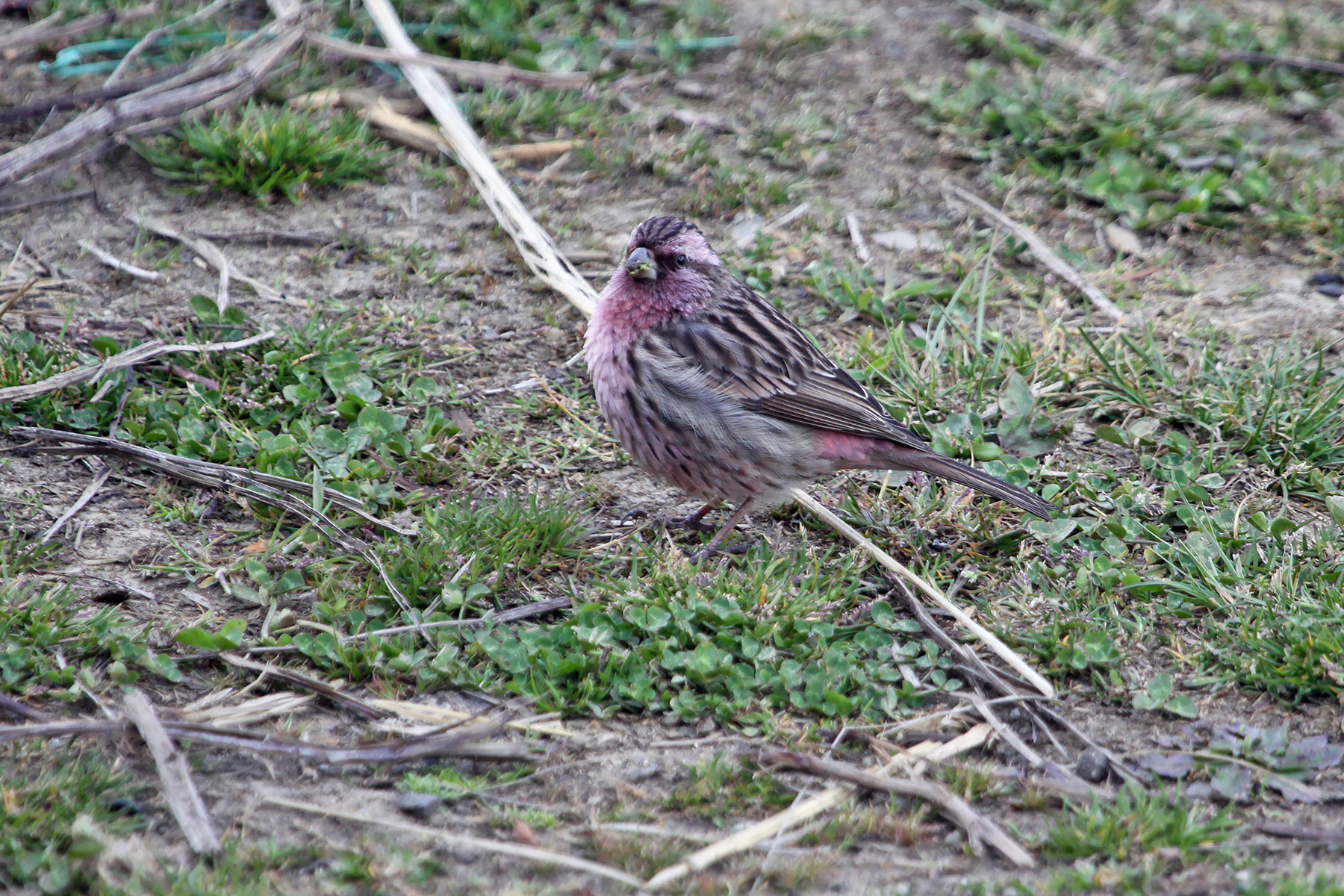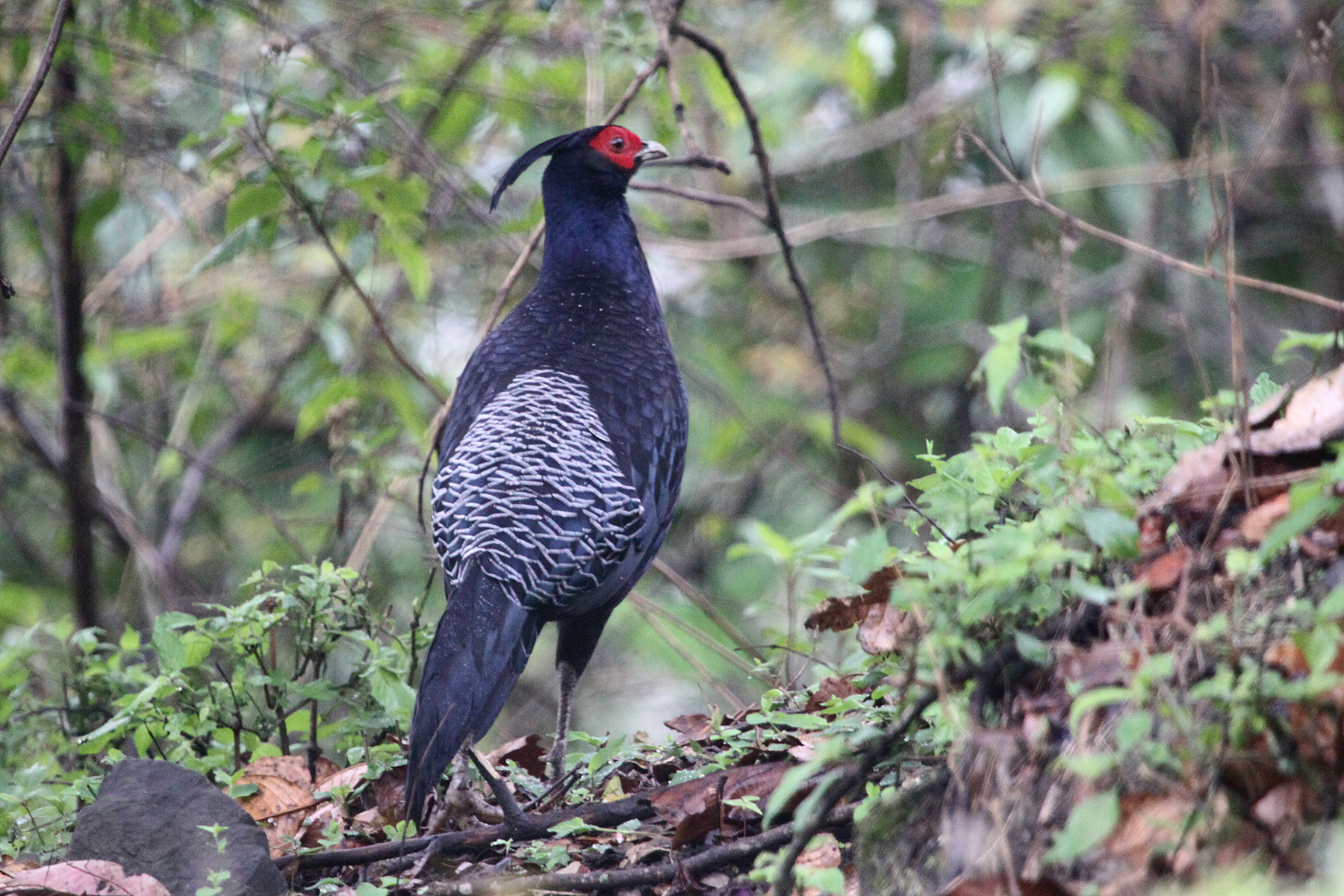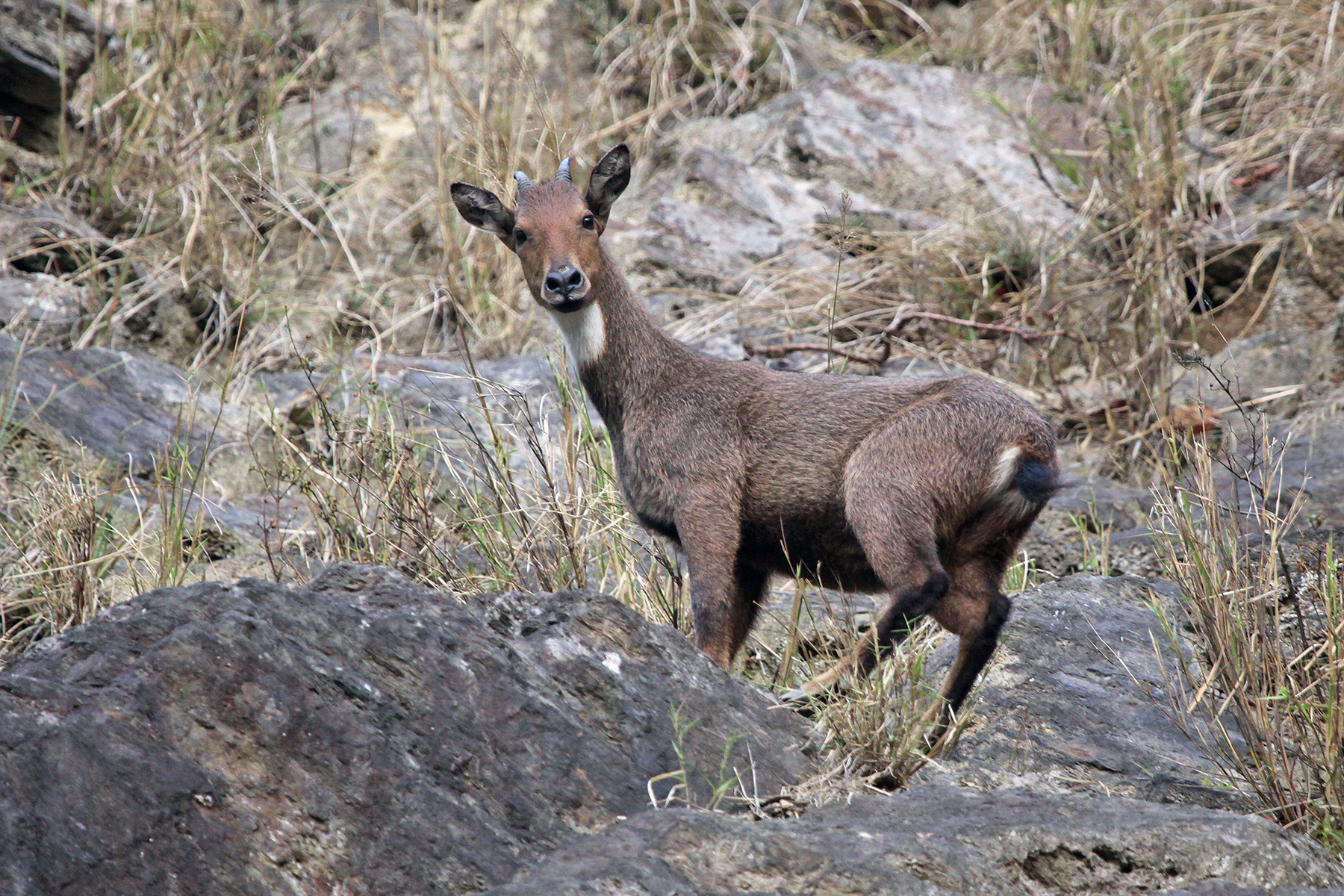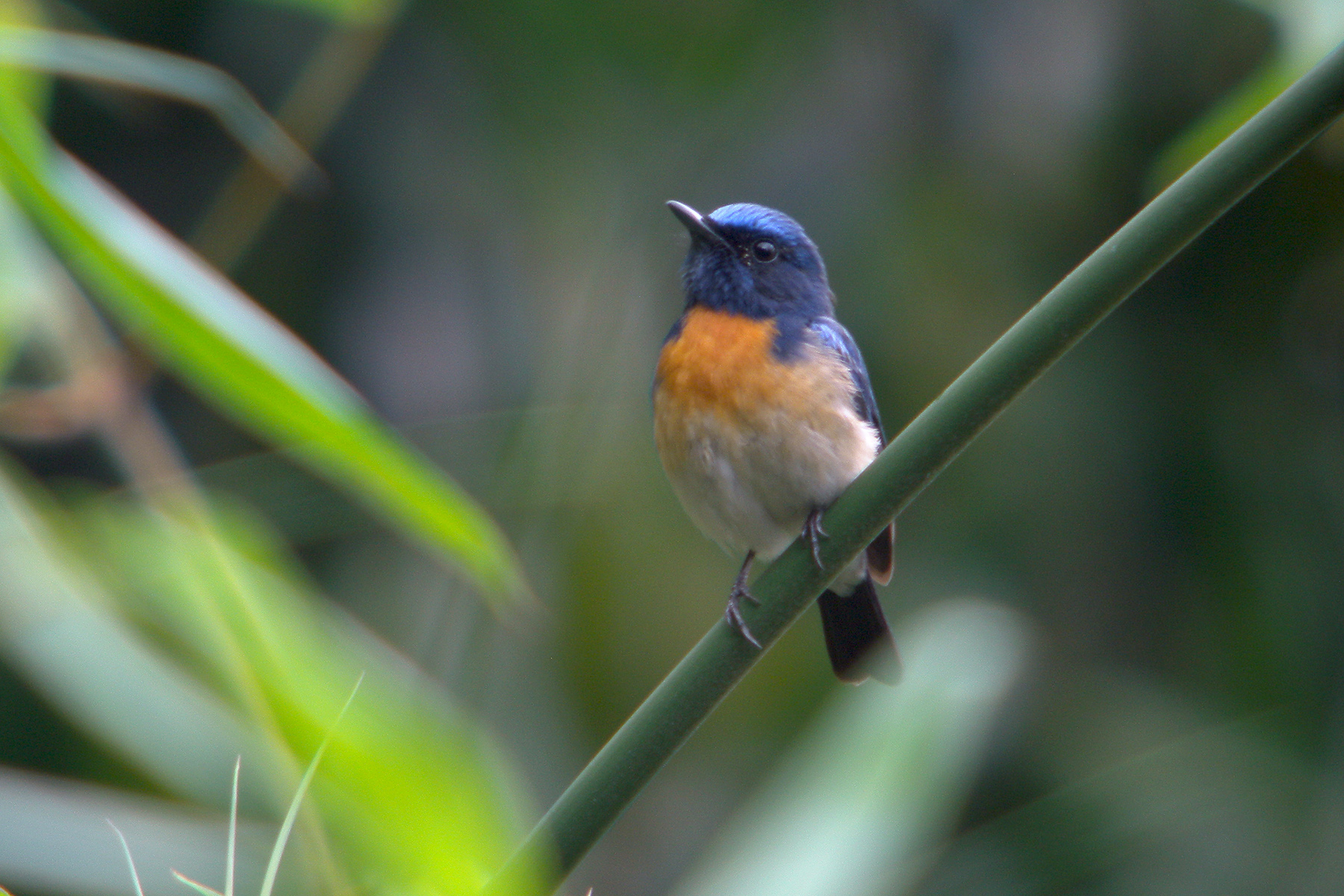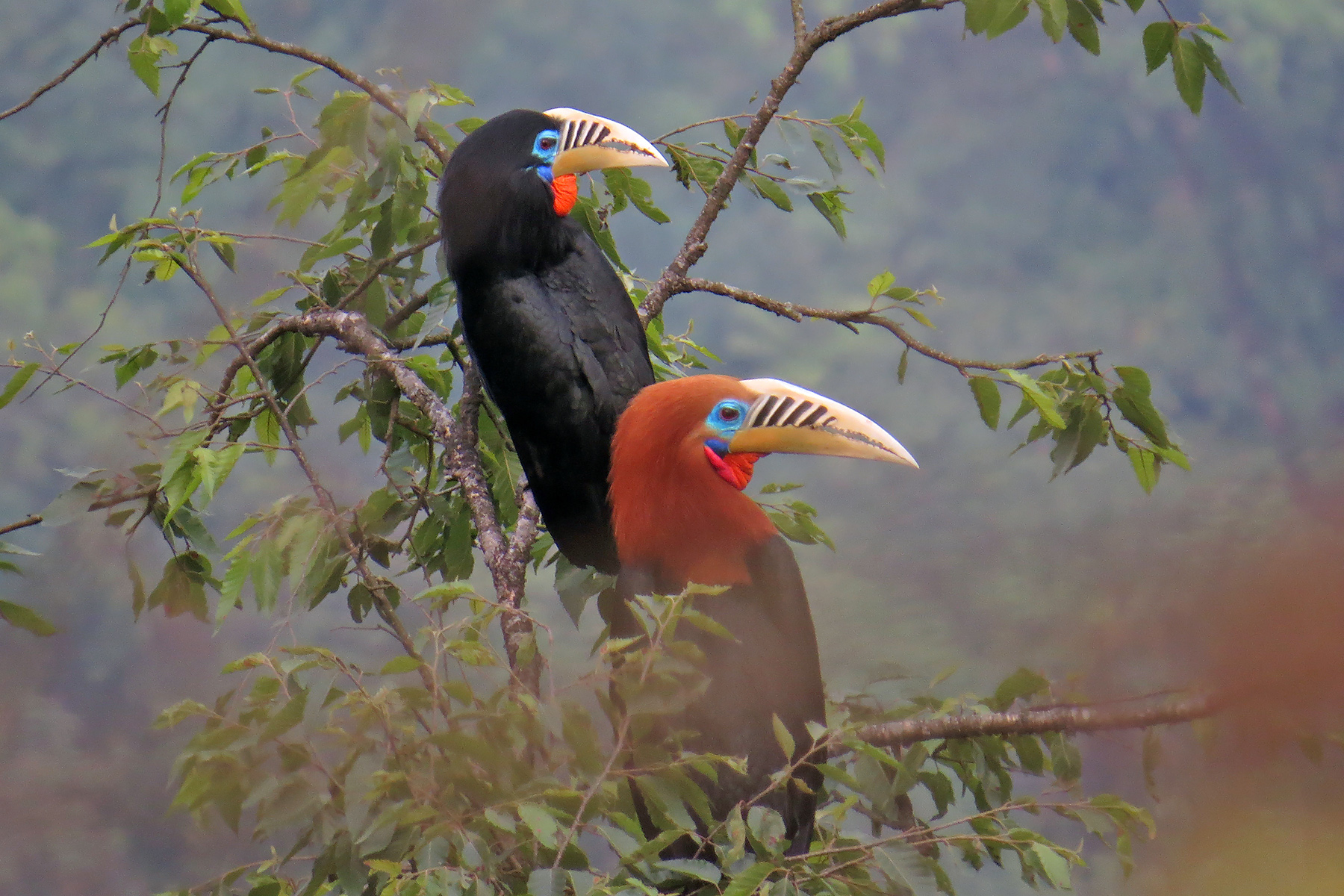NORTHEAST INDIA BIRDING TOUR: DETAILED ITINERARY
Northeast India: Day 1 Our tour begins this morning at Guwahati in Assam state in Northeast India.
(There are frequent flights into Guwahati from Delhi and Kolkata. We will be pleased to arrange your internal flight to Guwahati from your gateway city in India on request, even if you are not arranging your international flights through us. It is possible to arrive into Guwahati on the first flight this morning if you wish. We can also arrange an overnight stay for you in Guwahati if you prefer to fly in the previous day and get some rest before the tour.)
From Guwahati, we cross the mighty Brahmaputra River on our way to the remote town of Dirang in Arunachal Pradesh where we will stay for three nights.
Along the way to the base of the Himalayas, a range of commoner Indian birds will be on show in the fields and along the roadside, such as Great and Eastern Cattle Egrets, Black and Black-shouldered Kites, Asian Palm and House Swifts, Indochinese Roller, Black Drongo, Ashy Woodswallow, House and Eastern Jungle Crows, Common and Great (or White-vented) Mynas, Oriental Magpie-Robin and Eurasian Tree Sparrow.
Once we cross the border into the state of Arunachal Pradesh, we continue northwards into the Himalayas, skirting the border with Bhutan. Along the way, we will only have brief opportunities for birding in the extensive pristine forests of Pakke Tiger Reserve and Sessa Orchid Sanctuary, which both abut the road, as we will want to press on so that we can start birding the superb Dirang area late this afternoon.
Northeast India: Days 2-3 Some 25km west of Bomdila, at the boundary between West Kameng and Tawang districts, lies Dirang, our birding base for sorties into the Sangti Valley and along the Mandala and Sela Pass roads.
The Sangti Valley, which is close to Dirang, supports India’s only known wintering flock of the threatened Black-necked Crane. Unfortunately, the cranes are usually gone by early March, but there will be plenty of other interesting species to search for, in particular Black-tailed Crake, which can still be found in small patches of marshy rank grass and reeds, and Long-billed Plover (which has recently been found to breed here).
At 1500-1600m (4921-5249ft) elevation, this dry-flanked valley has a selection of habitats varying from pine and broadleaved woodland and cultivation to riverine shingle banks. Small mixed flocks of leaf-warblers often hold Blyth’s Leaf Warblers and these are joined by Black-throated Bushtits and Green-backed and Yellow-cheeked Tits. Other birds in the wooded habitat include Ashy and Mountain Bulbuls. Flowering oaks in the area very occasionally attract the nomadic, attractive Fire-capped Tit. The valley-cultivation provides a home for Long-tailed Shrike, Oriental Skylark, Brown-flanked Bush Warbler, Blue-fronted Redstart, Russet Sparrow, Yellow-breasted (or Himalayan) Greenfinch and Little Bunting. The boulder-strewn rivers and streams provide suitable habitat for Crested Kingfisher, Plumbeous Water Redstart, White-capped Redstart and Grey Wagtail. Other species that we should find here are Himalayan Buzzard and Large-billed Crow, while we might also encounter Slender-billed Oriole or Lemon-rumped Warbler.
The second venue in this remote region, still not well-known ornithologically, is the wonderful Mandala Road, which climbs from Dirang Dzong (a fortified Buddhist monastery situated just south of Dirang) up through temperate broadleaved evergreen forest, then oak-rhododendron forest with bamboo, to conifer-clad ridge-tops at 3500m (11483ft). Birding from the narrow road, we will sample the birdlife of all the habitat zones between 1700m (5577ft) and 3500m.
Early mornings on the cool ridge-tops see a flurry of bird activity. Mixed flocks of tits, small babblers, including the restricted-range Brown-throated (or Ludlow’s) Fulvetta, and Ashy-throated Warblers work through the open forest and are often joined by Stripe-throated and Rufous-vented Yuhinas and Buff-barred Warblers. Thrushes and chats are often in evidence, notably White-collared Blackbird, Alpine Thrush, Blue-capped Rock Thrush, Himalayan Bluetail and often White-browed and Golden Bush Robins. Spotted Nutcrackers utter their raucous but atmospheric calls from exposed conifer branches, while Hume’s Bush Warbler, the boldly-marked Bar-winged Wren-Babbler, Black-faced Laughingthrush and the beautiful Spotted Laughingthrush call out from denser areas.
The rich broadleaved evergreen forests still have some fantastic large trees, smothered in moss and epiphytes. Birds that we will expect to find include Himalayan Cuckoo, Crimson-breasted and Rufous-bellied Woodpeckers, Yellow-billed Blue Magpie and the cheeky White-tailed Nuthatch. Thicker vegetation along the forest edge is a good place to look for the restricted-range Bhutan Laughingthrush, as well as Chestnut-crowned Laughingthrush of the highly distinctive nigrimentum race, and we will also be on the lookout for the restricted-range Rufous-fronted Bushtit, Yellow-browed Tit, Streak-breasted Scimitar Babbler, Rufous-capped Babbler, Red-billed Leiothrix, Bar-throated Minla, the exquisite Golden-breasted Fulvetta (that quintessential Eastern Himalayan gem), Rufous-winged Fulvetta, Beautiful Sibia, Whiskered Yuhina, the noisy Black-faced Warbler, Grey-hooded Warbler, Oriental White-eye, Grey-headed Canary-flycatcher, Verditer, Little Pied and Rufous-gorgeted Flycatchers, and Green-tailed Sunbird. Small gullies and overgrown log-piles shelter Scaly-breasted Cupwing and Chestnut-headed Tesia.
Scrubby areas, close to the bottom of the road, are a good place to look for the rather skulking Rufous-chinned Laughingthrush, as well as Russet and Grey-sided Bush Warblers, while the streams sometimes provide habitat for Spotted Forktail. Bamboo brakes are frequent all along the road and, in these, we have a very good chance of seeing the superb Slender-billed (or Sickle-billed) Scimitar Babbler.
During our exploration of the Dirang area (and also at Eaglenest) we will constantly be on the lookout for the amazing Fire-tailed Myzornis, which often seeks out flowering rhododendrons or tree-sap, sometimes in company with the lurid and more common Fire-tailed Sunbird.
We should also run into some of the rarer species of the area, which include Temminck’s Tragopan, Great and Fulvous Parrotbills, Rusty-flanked and Hodgson’s Treecreepers, Ultramarine Flycatcher, Yellow-bellied Flowerpecker, Dark-breasted and Dark-rumped Rosefinches, and Tibetan Serin. The superb Red Panda has also been seen here, though we would count ourselves extremely lucky to see one.
Finally, the highest venue and, in many ways the best! A steep winding road leads some 60 km from Dirang up to the Sela Pass which, at 4176m (13701ft), is one of the highest motorable passes in the Himalayas. As we thread our way through the steep forested valleys, we will gradually ascend through changing habitat zones, finally emerging above the conifer-dominated treeline at the barren and rocky pass. By the time of our visit, the temperatures should be rising, and the snows melting, and we will hopefully be treated to a stunning view of rugged peaks stretching away as far as the eye can see.
In the open landscape above the treeline, we will be on the lookout for the well-camouflaged Snow Partridge, flocks of Snow Pigeons and the strange Grandala, which looks like a cross between a thrush and a starling, and which regularly soars above the slopes. Himalayan (Griffon) Vultures may be seen soaring around the slopes. Closer to the forest limit, we will scan the slopes for that classic high-montane pheasant, the Himalayan Monal, and listen for its curlew-like cries.
Moving back down to the upper forest levels, sprinkled with conifers and birch, we will explore a series of tracks and trails in search of the superb Blood Pheasant. Busy bird-waves contain Rufous-vented, Coal and Grey Crested Tits, while with a bit of luck the scrub at the forest edge will provide cover for the restricted range Rufous-breasted Bush Robin.
Mountain streams hold White-throated Dipper (which here replaces the Brown Dipper ) and if we are in luck Little Forktail as well. The sought-after Solitary Snipe winters in the area, and if we are lucky we will come across a lingering individual.
Other species that we will be looking for include the restricted-range Tibetan Blackbird as well as Red-billed Chough, Eurasian Wren, the lovely White-throated Redstart, Alpine and Rufous-breasted Accentors, Olive-backed and Rosy Pipits, Himalayan White-browed Rosefinch and White-winged Grosbeak. Plain and Brandt’s Mountain Finches, and also the large Red-fronted Rosefinch, are sometimes present.
Northeast India: Day 4 After some final birding in the Dirang region we will drive south via the Phudung road and Tenga to Lamacamp, situated at 2350m at the edge of Eaglenest Wildlife Sanctuary, for the first of our five nights at Eaglenest. In the late afternoon, we will begin our exploration of the sanctuary.
Northeast India: Days 5-8 Eaglenest Wildlife Sanctuary covers some 218 square kilometres (84 square miles) and spans an altitudinal range of 500–3200m (1640-10499ft). The big advantage that Eaglenest has over other wilderness areas in Arunachal Pradesh is its combination of altitudinal range and easy access, with a drivable jeep track cutting through the sanctuary from its base at 500m altitude to the Eaglenest Pass at 2800m (9187ft). The selection of Eastern Himalayan specialities in this area and the paucity of visitors have combined to give the place a magical, almost mythical quality, with the allure of untried trails in wonderful temperate forests where few foreigners have ventured. In places, the broadleaved evergreen forest exhibits a pristine tight canopy which stretches unbroken as far as the eye can see.
We will base ourselves at two well-established campsites: Lamacamp and Bompu. All of our time in the sanctuary will be spent exploring the rich, and largely untouched, montane broadleaved evergreen forest, with areas of bamboo, secondary growth, and scrub. At the higher levels, there will also be conifers, while at the lower levels the broadleaved forests become more sub-tropical, and there are also clearings and areas of upland agriculture.
In late 2006 the first new species to be discovered in the Indian subcontinent for many decades was described in the form of the beautiful Bugun Liocichla. We can expect to find this rare Indian endemic which is, so far, almost exclusively known from the Lamacamp area!
During early spring, many birds are likely to still be massed together in roving bird-waves, which can include (depending on elevation) Speckled and perhaps White-browed Piculets, Grey-chinned and Short-billed Minivets, Yellow-bellied Fantail, White-bellied Erpornis, Blyth’s, Green and Black-eared Shrike-babblers, Bronzed and Lesser Racket-tailed Drongos, Yellow-vented, Chestnut-crowned, Grey-cheeked and Whistler’s Warblers, Striated Laughingthrush, Golden and perhaps Grey-throated Babblers, Rusty-fronted and Streak-throated Barwings (the latter of the distinctive form daflaensis), Blue-winged and Red-tailed Minlas, Nepal Fulvetta, Striated and Black-chinned Yuhinas, Black-throated (or Black-breasted) Sunbird and Streaked Spiderhunter. There will also be a sprinkling of real gems among them, like Black-headed Shrike-babbler, Himalayan Cutia (but it is uncommon here, unlike at Mishmi), Yellow-throated Fulvetta, Long-tailed Sibia, White-naped Yuhina, the much sought-after Beautiful Nuthatch and Mrs Gould’s Sunbird.
The list of Galliformes at Eaglenest is impressive, with three species of Arborophila partridge, Hill, Rufous-throated and the restricted-range Chestnut-breasted all possible. Pheasants include the wonderful Temminck’s and Blyth’s Tragopans (but both are difficult here), along with the more widespread Kalij Pheasant and Grey Peacock-Pheasant. We should hear all or almost all of these species, though seeing them will require patience and our success rate will also depend on luck.
The Eastern Himalayas is also a great place to see flycatchers, and here we should add Slaty-blue, Snowy-browed, White-gorgeted and Pale Blue Flycatchers, as well as Large, Small and Rufous-bellied Niltavas. We could also find Large Blue Flycatcher, which has recently become easier here.
In the canopy will be frugivores like Mountain Imperial Pigeon and the striking Rufous-necked Hornbill, Careful scanning of the mid-storey may well be rewarded with a sighting of the superbly pink male of the restricted-range Ward’s Trogon, which is well distributed here in the moss-draped stands of old-growth forest.
Dense vegetation bordering the jeep-track and the forest understorey harbour such gripping birds as Pygmy Cupwing, Broad-billed Warbler, Slaty-bellied and Grey-bellied Tesias, Rufous-throated Wren-Babbler, the almost mini-kiwi-like Long-billed Wren-Babbler, Sikkim Wedge-billed Babbler, Red-faced (or Crimson-faced) Liocichla, Spotted Elachura (formerly Spotted Wren-Babbler and now a monotypic bird family), and Scarlet and Gold-naped Finches.
In areas of bamboo, at varying elevations, we will be looking for the black-capped nominate race of the Coral-billed Scimitar Babbler, Brown and White-breasted Parrotbills, the tiny but super-energetic Black-throated (or Grey-breasted) Parrotbill, Yellow-bellied Warbler, the delightful little Rufous-faced Warbler and the rather retiring White-spectacled Warbler. More uncommon are Pale-headed Woodpecker and White-browed Scimitar Babbler.
Other birds regular at Eaglenest include Crested Goshawk, Black Eagle, Mountain Hawk-Eagle, Speckled Woodpigeon (uncommon), Common Emerald Dove, Barred Cuckoo-Dove, Large Hawk-Cuckoo, Red-headed Trogon, Great, Golden-throated and Blue-throated Barbets, Bay and Darjeeling Woodpeckers, Greater Yellownape, Long-tailed Broadbill, Bar-winged Flycatcher-shrike, Black-winged Cuckooshrike, Maroon Oriole, Ashy Drongo, White-throated Fantail, Striated, White-throated and Black Bulbuls, Common Green Magpie, Grey Treepie, Mountain and Dark-necked Tailorbirds, Black-throated Prinia, White-crested, Grey-sided and Blue-winged Laughingthrushes, Silver-eared Mesia, the superb Green Cochoa, White-tailed Robin, Black-backed Forktail (uncommon), Chestnut-bellied Rock Thrush, Blue Whistling Thrush, Sikkim (or Brown-throated) Treecreeper, Brown Dipper, Orange-bellied Leafbird, Fire-breasted Flowerpecker and Brown, Red-headed and Grey-headed Bullfinches. At dawn and dusk, we should see thrushes venturing onto the jeep-track, with the local selection including Scaly Thrush and Grey-winged Blackbird.
There is a range of nightbirds at Eaglenest, including Mountain Scops Owl, Himalayan Owl, Collared Owlet, Hodgson’s Frogmouth and Grey Nightjar, so we will try and locate as many as possible.
With a lot of luck, we could also find one or two of the toughest inhabitants of the area, which include Purple Cochoa, Green-crowned Warbler, Scaly and Rufous-vented Laughingthrushes, Maroon-backed Accentor and Crimson-browed Finch.
Northeast India: Day 9 After some early morning birding at Eaglenest, we return to the plains of Assam as we head for famous Kaziranga National Park for a two nights stay.
Northeast India: Day 10 The famous Kaziranga National Park needs little introduction. It is one of the most important reserves in the world, let alone the Indian subcontinent, being one of the last refuges for large numbers of Asian (or Indian) One-horned Rhinoceros, Swamp Deer (or Barasingha) and wild Water Buffalo. Roughly three-quarters of the surviving populations of each of these species live in the park. We will have opportunities to admire all three of these impressive animals, along with Asian (or Indian) Elephant and Hog Deer. Tigers occur at Kaziranga, but we would count ourselves lucky if we came across one during a short visit.
Our excursions into the park will be by open-topped jeep, with regular stops at watch-towers and other vantage points, where we will be treated to some superb panoramic views of the grassland, marshes and lakes dotted with herds of large mammals and an impressive array of waterbirds.
Although annually burnt to provide grazing for mammals, the extensive grassland in the park hold a number of rare and restricted-range birds. We will have a very good chance of seeing a number of threatened or endangered species, including Swamp Partridge, the critically endangered Greater Adjutant (now largely restricted to Assam and Cambodia), Slender-billed Vulture, Slender-billed Babbler, and both Bristled and Indian Grassbirds. Bengal Florican has become more difficult to find at Kaziranga and it takes a lot of luck to encounter the rare and localized Finn’s Weaver.
Other grassland birds include Lesser Coucal, Green Bee-eater, Ashy and Plain Prinias (the local form of the latter, fusca, may be split in future as Brahmaputra Prinia), Striated Grassbird, Chestnut-capped and Striated Babblers, Siberian Stonechat and the uncommon Black-breasted Weaver.
Scattered throughout the grassland tracts are a series of shallow wetlands which support good numbers of waterfowl, shorebirds and other waterbirds, including the near-threatened Spot-billed Pelican, as well as Lesser Whistling Duck, Ruddy Shelduck, Cotton Pygmy Goose, Eurasian Wigeon, Indian Spot-billed Duck, Eurasian Teal, Little and Great Cormorants, Oriental Darter, Little and Intermediate Egrets, Grey and Purple Herons, Indian Pond Heron, Asian Openbill, Woolly-necked and Black-necked Storks, Lesser Adjutant, Black-headed Ibis, White-breasted Waterhen, Common Moorhen, Grey-headed Swamphen, Bronze-winged Jacana, Red-wattled Lapwing, Pin-tailed and Common Snipe, Spotted Redshank, Common Greenshank, Green, Wood and Common Sandpipers, Temminck’s Stint, River and Whiskered Terns, and Common, Stork-billed, White-throated and Pied Kingfishers.
We should also see good numbers of raptors, and we will be on the lookout for the threatened Pallas’s Fish Eagle in particular, as well as Crested (or Oriental) Honey Buzzard, Black Baza, Brahminy Kite, Grey-headed Fish Eagle, Red-headed Vulture, Crested Serpent Eagle, Pied Harrier (uncommon at this season), Shikra, Changeable Hawk-Eagle and Peregrine Falcon.
Small areas of open woodland and belts of trees shelter plenty of additional species and we have a good chance of seeing Fulvous-breasted Woodpecker as well as such widespread species as Red Junglefowl, Oriental Turtle, Red Turtle and Spotted Doves, Yellow-footed Green Pigeon, Green Imperial Pigeon, Asian Koel, Common Hawk-Cuckoo, Plaintive, Banded Bay and Indian Cuckoos, Greater Coucal, Green-billed Malkoha, Asian Barred and Spotted Owlets, Blue-bearded and Chestnut-headed Bee-eaters, Eurasian Hoopoe, Oriental Pied and Great Hornbills, Lineated and Coppersmith Barbets, Grey-capped Pygmy, Streak-throated (uncommon) and Grey-headed Woodpeckers, Lesser Yellownape, Greater and Black-rumped Flamebacks, and Alexandrine, Rose-ringed, Red-breasted and Blossom-headed Parakeets.
Passerines include Common Iora, Small and Scarlet Minivets, Large Cuckooshrike, Grey-backed Shrike, Black-hooded Oriole, Hair-crested Drongo, Black-naped Monarch, Rufous Treepie, Cinereous Tit, Bengal Bushlark, Red-vented and Red-whiskered Bulbuls, Grey-throated Martin, Barn and Striated Swallows, Dusky, Tickell’s Leaf, Greenish, Thick-billed and Blyth’s Reed Warblers, Common Tailorbird, Pin-striped Tit-Babbler, Abbott’s and Puff-throated Babblers, Velvet-fronted Nuthatch, Indian Pied and Common Hill Mynas, Taiga Flycatcher, White-rumped Shama, Golden-fronted Leafbird, Scarlet-backed Flowerpecker, Ruby-cheeked and Crimson Sunbirds, Citrine and Western Yellow Wagtails, and Paddyfield Pipit. This is a good area for the shy Blue-naped Pitta, but often they can be unresponsive.
At this season, the large number of red-flowered Bombax trees attract flocks of Jungle Mynas and Chestnut-tailed Starlings and occasionally the rarer, restricted-range Spot-winged Starling.
Northeast India: Day 11 After some early morning birding at Kaziranga we will head southeastwards into the state of Nagaland, where we will spend a total of five nights, divided between Khonoma (situated not far from the state capital, Kohima) and the remote settlement of Chezame.
Northeast India: Days 12-15 Nagaland is a wild and rugged border state of India, where classic slash-and-burn or ‘Jhum’ agricultural practices predominate, and it has a turbulent tribal history. Things became more settled after British colonial intervention in the mid-19th century, and the prevalent religion today is Christianity. Nagaland is perhaps most famous for its Second World War history when British and Indian troops successfully repelled Japanese forces, which were attempting to invade India, during a prolonged and fierce battle in the spring of 1944; The Battle of Kohima.
Khonoma gained significance in the birding world when local residents took an active part in preserving the local forests and their wildlife. In 1998, they set up the Khonoma Nature Conservation and Tragopan Sanctuary and, in 2000, an area of 7000 ha was declared as a Community Conserved Reserve (CCR), and hunting was banned. This safe haven is privately owned and managed by the village community. The local Angami villagers are primarily subsistence rice farmers but are apparently famed for their warriors, who contributed to the Indian struggle for independence.
During our stay in Nagaland, we will explore the middle-altitude forests up to about 2500m (8202ft). Here, two of our primary targets are the diminutive endemic Naga Wren-Babbler and the little-known, near-endemic Yellow-throated Laughingthrush, which prefers cut-over forest, scrub and grass. We should also see four other major specialities; the restricted-range Assam Laughingthrush and the near-endemic Striped and Brown-capped Laughingthrushes and Spot-breasted Scimitar Babbler, as well as the distinctive austeni race of the White-browed Fulvetta. If we are fortunate we will encounter the skulking, restricted-range and outstandingly vocal Spot-breasted Laughingthrush. We will also have a good opportunity to see the lovely, restricted-range Blyth’s Tragopan and the rare Dark-rumped Swift.
The bulk of the avifauna in Nagaland is typically Himalayan, but we should also find some species with a more Southeast Asian flavour, including Mountain Bamboo Partridge, Burmese Shrike, Crested Finchbill, Flavescent Bulbul, Chestnut-vented Nuthatch, Black-breasted Thrush and Rusty-capped Fulvetta. Additional targets include Brown Bush Warbler, White-browed Laughingthrush, Grey Sibia, Lesser Shortwing and, with luck, Spot-breasted Parrotbill. We should also encounter Black-tailed Crake again.
Northeast India: Day 16 Today is a long travel day as we say farewell to Nagaland and pass through the tea estates and ricefields of Assam en route to the busy town of Tinsukia for a two nights stay.
Northeast India: Day 17 Early this morning we will visit an area of logged but nowadays undisturbed forest at Digboi, which is one of the best places to see the little-known, restricted-range Chestnut-backed Laughingthrush and Collared Treepie. In addition, the regionally-endemic White-cheeked Partridge is sometimes encountered.
Situated in the Brahmaputra floodplain and wedged between two major rivers, the Dibru and the mighty Brahmaputra, is the impressive Dibru-Saikhowa National Park, which protects an extensive mosaic of swamp forest, grassland and shallow wetlands. Most of our time in and around the park will be spent in search of the grassland specialities along the ever-changing banks of the Dibru River, particularly two northeast Indian endemics, the highly skulking Marsh Babbler and the impressive Black-breasted Parrotbill, as well as the restricted-range Jerdon’s Babbler. A third regional endemic, Swamp Grass Babbler, used to be seen here regularly but is now only very rarely encountered.
Amidst this variety of open and wetland habitats, we will also expect to add most of the following to our growing tally: Little Grebe, Striated Heron, Sand Lark, Yellow-eyed Babbler and Baya Weaver. Less regular are Yellow and Cinnamon Bitterns, Delicate Prinia and Chestnut Munia.
Lingering winter visitors could include the restricted range Smoky Warbler, as well as Black Stork, Spotted, Baikal and Chestnut-crowned Bush Warblers, Paddyfield Warbler, Richard’s Pipit and Black-faced Bunting.
The Dibru River, which forms the southern boundary of the park, is an excellent site for the endangered, virtually blind, and amazingly long-snouted Ganges Indus Dolphin; which is currently only known from less than 20% of its original range. There are also wild Water Buffaloes in the area.
Northeast India: Day 18 Today we will head north-east and make our way to the Mishmi Hills for a four nights stay.
The huge Brahmaputra River is an amazing sight and soon we are crossing the Arunachal Pradesh border before reaching the town of Roing at the foot of the hills.
Along the way, we will visit another grassland area that holds both Marsh Babbler and Black-breasted Parrotbill, and also Zitting and Golden-headed Cisticolas, Grey-breasted Prinia, Rufous-necked Laughingthrush and Siberian Rubythroat.
We will reach the Mishmi Hills in time for some initial exploration.
Northeast India: Days 19-21 The rugged Mishmi Hills have barely been explored ornithologically. During a post-war expedition led by Salim Ali and S. Dillon Ripley, to a different part of the hills, the discovery was made of a bird endemic to the region, the Rusty-throated (or Mishmi) Wren-Babbler. Although quite common in these remote hills, it remained unrecorded again until its re-discovery by Ben King in December 2004!
Since that time a relatively small number of adventurous birders have visited the area, and during our stay we will enjoy exploring the still extensive forests along the 90km Roing-Hunli road, reaching a maximum elevation of about 3000m (9843ft). Most of the birds here overlap with the avifauna found at Eaglenest, but there are some very significant differences.
The high-elevation bamboo and roadside vegetation is home to the restricted-range Manipur Fulvetta, the beautiful, restricted-range Rusty-bellied Shortwing and, at the time we visit, the sought-after Gould’s Shortwing. We will also have another opportunity to find the gorgeous Fire-tailed Myzornis here in the Mishmis. Mid-elevation gullies hold the strange, restricted-range Cachar Wedge-billed Babbler, as well as the endemic Mishmi Wren-Babbler.
There is still little or no traffic along the narrow paved road here, and a number of species, like Maroon Accentor, the uncommon Rufous-breasted Bush Robin and Dark-rumped Rosefinch can be more confiding than usual.
Other new birds at Mishmi are likely to include Blyth’s Swift, Rufous-backed Sibia, Pale-billed Parrotbill and the lovely Blue-fronted Robin, as well as more widespread species such as Eurasian Sparrowhawk, the manic Hodgson’s Hawk-Cuckoo, Square-tailed Drongo-Cuckoo, Himalayan Swiftlet, White-browed Piculet, Eurasian Jay (here of the form bispecularis), Nepal House Martin, Chestnut-bellied Nuthatch, White-browed Shortwing, White-hooded Babbler, Pygmy (Blue) Flycatcher and Dark-breasted Rosefinch.
We also have further opportunities to encounter the superb Blyth’s Tragopan, Hill and Rufous-throated Partridges, Rufous-necked Hornbill, Himalayan Cutia (easier here than at Eaglenest) and Beautiful Nuthatch.
During our time in the Mishmi Hills, we have a good chance of finding several of the scarcer species that occur here, which include Chestnut-breasted Partridge, Himalayan Owl, Red-billed (or Orange-billed) Scimitar Babbler, Eyebrowed Wren-Babbler, Fulvous Parrotbill, the superb Green and Purple Cochoas, Yellow-bellied Flowerpecker, Crimson-browed Finch and Collared Grosbeak. We even have a slim but real chance of seeing Sclater’s Monal!
Northeast India: Day 22 Birding along the way, we will make our way down from the Mishmi Hills and then return to Tinsukia in Assam for an overnight stay.
Northeast India: Day 23 This morning we will visit Dihing Patkai National Park, a wonderful area of lowland forest not far from Tinsukia. In addition to many lowland forest birds we will have seen earlier in the tour, we will be on the lookout for White-cheeked Partridge (more often heard than seen), the restricted range Austen’s Brown Hornbill, Ruddy and Oriental Dwarf Kingfishers, Hooded Pitta, the uncommon Pale-capped Pigeon and Rufous-throated Fulvetta. If we are very lucky we will encounter the rare White-winged Duck, which is breeding in the area.
Our tour ends at Dibrugarh airport around midday.
(There are regular flights from Dibrugarh to Delhi or Kolkata. We will be pleased to arrange your internal flight to your gateway city in India on request, even if you are not arranging your international flights through us.)




